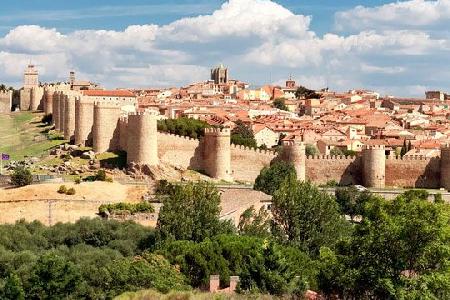
Ávila is a medieval city in the province of Castilla y León in western Spain, about 70 kilometers northwest of Madrid. Founded in the 11th century to protect the Spanish territories from Muslims, Ávila has a beautifully preserved wall, a historic cathedral, several Romanesque churches, and an authentic medieval atmosphere. For all these reasons, the entire Old Town of Ávila has been designated a UNESCO World Heritage Site. For pilgrims, the city of Ávila is important for its association with the great mystic and reformer Santa Teresa de Jesús, better known as Santa Teresa de Ávila. Teresa was a 16th century Carmelite nun who reformed her order, had many ecstatic visions, and wrote several books. She is the patron saint of Spain and was the first woman to be named Doctor of the Church. Ávila contains two main sanctuaries in honor of Santa Teresa, along with some sites more associated with the saint. The main sanctuary is the Convent of Santa Teresa, a convent that contains her relics, and the second is the Monastery of La Encarnación, where Santa Teresa lived and where her cell can be visited.
Royal Monastery of San Tomas:
The Royal Monastery of San Tomás was founded in 1482 with funds provided by Fernando and Isabel, the kings of Spain at the time. The monastery was the headquarters of Fray Tomás de Torquemada, adviser to the king and first Grand Inquisitor of Spain, who led the great witch hunts of the 15th century. The monastery has three cloisters called Novitiate, Silence and Kings, or Novitiate, Silence and Kings, with the third cloister housing the Museum of Oriental Arts.
Ávila Cathedral:
Considered the first Gothic cathedral in Spain, the Ávila Cathedral is an imposing building within the city walls and is one of the great sites of Ávila. Little is known about the origin of the cathedral, but theories suggest that it was built in 1091 on the foundations of a church ransacked by Muslim invaders. The cathedral was built as a place of worship and as a defensive structure, its apse being one of the turrets of the city walls. The style of the cathedral is very reminiscent of French religious architecture from medieval times, especially the Church of San Dionisio, which has led historians to believe that it could have been designed by the same person.
The medieval walls of Ávila:
The walls of Ávila are the most emblematic and imposing historical monuments in the city. Built in the 11th century, the construction of the ramparts was commissioned by Alfonso VI after conquering the city in 1090. The ramparts are nearly two miles long and 45 feet high with 100 towers, nine gates, and three openings. The walls surround the old city of Ávila, and were once a sample of the power that those who ruled had during medieval times. The walls are the most recognizable monument in the province and a popular attraction for visitors.
The Four Posts (Los Cuatro Postes):
Los Cuatro Postes is a small sanctuary 1.5 km away. from the walled city of Ávila. A cross covered by a four-post canopy marks the place where, at the age of seven, Saint Teresa's uncle prevented her from fleeing with her brother to seek martyrdom in the battle against the Muslims. Located on top of a small hill, the site also offers good views of the famous medieval city walls.
